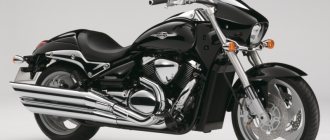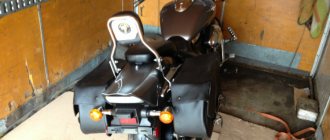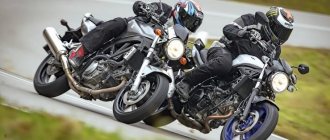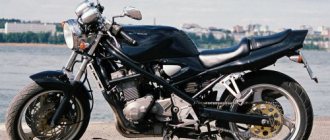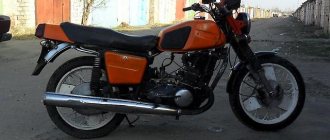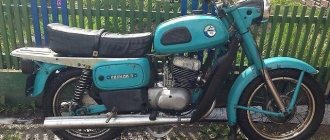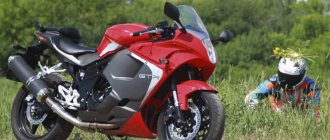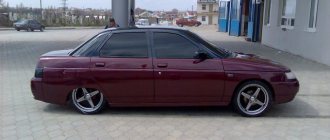Landing
To be honest, I sat down and drove off. And only then I realized that everything just “fell” as it should. And the legs “found” the pegs, and the hands were comfortably light on the steering wheel. Beauty! Only after about 15 minutes did I realize that the “default” position was not as relaxed as it seemed, and that my arched back couldn’t stand it for long. Fortunately, the sofa seat allows you to choose a fairly wide range of placement of the fifth point, but as a result I realized that I was trying to sit “on top” and not “in” the motorcycle, as it would be for cruisers, i.e. in other words, imitate the landing of the Seabikha. Hm. But at least the sensations were not as “extreme” (in fact, of course, all this is far from extreme) as on the C1500, where it felt like you had to reach for the steering wheel.
The “wingspan” on the Intruder was quite suitable for me with my height of 185 cm. Wide enough, but not “loose”, and at the same time it is comfortable to steer both at speed and in a parking lot. When I switched to CBF, in addition to the usual “narrowness” of the steering wheel, for some reason I got the feeling that my arms were “twisted” and not positioned “as they should be.” This has never happened to me before - am I “addicted” to cruisers? 
Evaluation of appearance and feel from test drive
The classic style of the bike is emphasized by numerous chrome parts, spoked wheels, a polished tank and fenders.
In the city the motorcycle behaves quite modestly. Due to its small dimensions, sometimes you have to stand in traffic jams on par with cars, and gearbox shifts are audible even at high speeds, however, the center of gravity shifted downwards adds maneuverability to the unit and confidence when cornering and driving at minimum speeds.
Once out on the highway, the Suzuki Boulevard C50 reveals its full potential. The Japanese can be accelerated to 160-170 km/h, but the maximum speed and headwind will not bring much pleasure from such a ride. The motorcycle is light in weight, making handling simple and pleasant. It leans easily when cornering and is “tamed” by the front brake disc at high speeds.
Box
The gears shift smoothly and, if you select the right speed (without a tachometer, but everything is clear from the sound and vibrations), then very smoothly and without jerking, but also without clear shifting. After a couple of tries, using heel-toe switching turned out to be very convenient. On this example, protective arches were installed and the toe of the boot kept trying to poke the arch, and not the switching foot, so switching up with the heel was just right. My only complaint is that I had to catch neutral every time. On the Sibikh this is an exception; I had to poke it back and forth several times. Maybe I just had to do it more gently out of habit.
There are only 5 passes, but to be honest, I didn’t “count” and didn’t suffer much. In the absence of a tachometer, everything goes by feeling from the fifth point: if it itches, then we stick the gear higher, if it’s not higher, then we can go slower :).
By the way, regarding the cardan, I didn’t have any comments compared to a chain or belt (like on the Vulcan). All manipulations with the throttle handle are transmitted smoothly and smoothly. The only incomprehensible point was the presence of a “howl” while driving, but after 47 thousand miles of the test unit, for some reason this did not bother me much :).
Reviews
Reviews of Suzuki Intruder C800 (Boulevard C50):
Expand Collapse
Suzuki VL800 Volusia. Advantages.
1. Excellent torque of the engine, especially at low speeds.
2. The large weight allows the motorcycle to have excellent directional stability and not react to gusts of wind on the highway.
3. Suspension travel (front: 140 mm, rear: 104 mm) in combination with the weight of the device allows you to pass uneven sections of roads without any inconvenience for the driver. The passenger, of course, reacts to this all completely differently.
4. Excellent sound from stock mufflers.
5. Appearance (of course, this is all purely personal preference). Graceful fenders, long mufflers, beautifully shaped tank. My motorcycle has a two-tone paint job - metallic gray, which is applied at the factory in three layers, plus one layer of varnish.
6. Comfortable wide steering wheel and soft seat.
7. Large tank of 17 liters.
8. Convenient location of the footrests - not too far forward.
9. The wind deflector installed by the American provides excellent wind protection and allows you to ride without any problems with your helmet visor slightly open. The edge of the windshield goes just below my eye level.
Flaws. About them subjectively, from the girl’s point of view. And about some objective ones.
1. Weight. Not the heaviest, but I find it difficult to reverse on inclines.
2. Far away clutch handle. It can probably be adjusted, but with this setting I can barely reach it with all my fingers.
3. Long wheelbase, large turning radius.
4. Hot right side.
5. Small mirrors. And they are also highly adjustable. I tightened it once with the key and that's it. If during the process you realize that you need to change the angle a little, then that’s it – tighten it again with the wrench.
Suzuki VL800 Volusia. I had a motorcycle like this.
A good mid-size cruiser. Wide saddle, glove compartment for small tools on the key. For 2 years there was not a single breakdown. It drives well, confidently, in turns you can lean up to the footpegs . There were no comments on the cardan, oil did not leak from anywhere. Irregularities go over well, smoothly, you can adjust the rigidity. The wings and other elements such as side covers are made of plastic. And in appearance it is like a 1.5 liter. Indistinguishable (almost)
Wide saddle, glove compartment for small tools on the key. For 2 years there was not a single breakdown. It drives well, confidently, in turns you can lean up to the footpegs . There were no comments on the cardan, oil did not leak from anywhere. Irregularities go over well, smoothly, you can adjust the rigidity. The wings and other elements such as side covers are made of plastic. And in appearance it is like a 1.5 liter. Indistinguishable (almost)
I drove the C50 for a season, it’s definitely one of the best in its class... For 5000 km (3500 of them with a full load) nothing broke off or flew, it works like a clock... I rode the M50, I’ll say that the difference is so imperceptible... in fact there is almost none... In general, if you like it, then don’t doubt it, definitely VESCH Well, about the Sportster 883, I rode it a little, looked at the performance characteristics, in all respects it smokes on the side.....
in fact there is almost none... In general, if you like it, then don’t doubt it, definitely VESCH Well, about the Sportster 883, I rode it a little, looked at the performance characteristics, in all respects it smokes on the side.....
Engine and exhaust
The engine is a classic V-twin, with quite pronounced “pulsation” at idle and vibration while driving.
The pulsation, however, is quite “civilized” - the bike does not “bounce” at idle and does not budge, “as a real Harley should,” but at the same time the rear wing actually shakes until you add gas, so there are vibrations. Check mark :). During active acceleration, the pulsation develops into a slight itching, although it is worth noting that no unnecessary vibration-massage effects are observed on the steering wheel. If on the Ducati my hands went numb quickly enough, then here all the feelings remained with me :). Your legs and butt are less fortunate - you feel a little like you’re on a vibration table. And to such an extent that the next time I drove onto the autobahn, I had the feeling that my legs simply could no longer stand on their legs, but were “moving” to the sides from the vibration. Not the best feeling. Regarding the exhaust, I made a “traditional” video, but, of course, it doesn’t reflect the full picture without the right microphone. In any case, you shouldn’t expect the “roar of a wounded bear” with a standard exhaust. It’s a fairly civilized “grunting” sound, although it’s quite enough to warn of your arrival without the alarms of the neighboring Ferraris going off.
Brakes
Cruisers are supposed to drive “at a distance” (just like the British - a gentleman should walk, not run :)), so there is absolutely no need to brake sharply. It seems that to emphasize this fact, Suzuki even left the classic drum brake instead of the “modern” disc back. In principle, the bike brakes well with its engine, and during the entire test drive, I only tried to grab the brake once when approaching a small circle, and I immediately realized the futility of such an action. It seems that instead of brake pads, the sponges shrank and gradually began the process of slowing down the “carcass”. In general, with a cruiser, braking needs to be calculated in advance, and not rely on the strength of squeezing (and pressing with your foot) the brake lever. But with one disc in front and a decent amount of kilograms of weight, you shouldn't expect anything else. In general, you can live... but be careful :).
By the way, due to the budget, they don’t install ABS on mid-sized ones. In general, it’s not a very good solution; they say (I didn’t succeed myself) that blocking the rear wheel is quite possible. I remember what it’s like from Diversion and “The Cat” and the feeling, to put it mildly, is not pleasant, because it usually happens due to panic. But there's nothing you can do about it. In this class, no one takes dogs out of their kennels for that kind of money or installs ABS.
Brief history of the model
- 2005 - start of production and sales of the Suzuki Boulevard S50 model.
Model
: Suzuki Boulevard S50 (North America).
Factory designation
: VS800K5.
- 2006 - no significant changes.
Model
: Suzuki Boulevard S50 (North America).
Factory designation
: VS800K6.
- 2007 - no significant changes.
Model
: Suzuki Boulevard S50 (North America).
Factory designation
: VS800K7.
- 2008 - no significant changes.
Model
: Suzuki Boulevard S50 (North America).
Factory designation
: VS800K8.
- 2009 - no significant changes.
Model
: Suzuki Boulevard S50 (North America).
Factory designation
: VS800K9.
Devices
The view from the driver's seat is no worse than the C1500 with a huge headlight, which effectively reflects the Intruder logo from the windshield and the clouds floating above and the crowns of trees. Two powerful pipes of the front fork shock absorbers complement the “locomotive” look. The instruments themselves are built into the tank (for some reason I like it, maybe because it’s a Harley classic?), while in the Boxer V8 visibility is quite normal, you don’t have to lower your head much. But in a regular full-face helmet the situation may be different, and to check the speed you would have to lower your head and take your eyes off the road. But either the devices are “beautiful on the tank” or “unaesthetic”.
This model did not yet have a gear indicator (is it necessary? This seems to be part of the “they solved a problem that I didn’t have” :)), but it already has an LCD fuel level indicator and at least a mileage indicator (as I understand with two daytime). There is no clock, but it’s convenient, by the way! All the bulbs are small but bright; for some reason I like them more than the “industrial” bulbs of the Kawasakov Vulcan. Maybe it looks more “modern” or sophisticated, or something. A matter of taste. Here my taste coincides more with Suzuki :).
Not really about instruments, but at a gas station I opened the tank filler cap with a key and... I was puzzled about what to do with the item that was left in my hands :). On regular motorcycles the cover is hinged, but here it is removed. And without a “chain” or “string”, like on a car. It just stays in your hand. Nde. I put it on the steering wheel, but the thought that I could forget or lose it somehow didn’t make me happy. With my forgetfulness, it’s not even possible to learn such things.
By the way, the switches turned out to be soft and very comfortable to use. Somehow I didn’t even expect it. On a Honda, you need to apply some effort, although we must pay tribute that the information content is at its best. You immediately feel what happened (or not). And here everything is soft and simple, but without any effort. Also an option, it’s called.
On the run
In fact, the most important thing was left for last :). After driving the Vulcan, I was very interested in the issue of the autobahn and speeds of more than 100 km/h, because the Vulcan “forced” me to drive no more than 110 km/h. But before getting to the autobahn, I first made my way through a couple of villages, then along local roads (80-100 km/h), and only then the autobahn. At the same time, in search of a place for photos, a couple of times I drove at a snail’s speed. And I must say that the Suz behaves very nicely at low speed! First gear can be a little fidgety, but overall, slow maneuvering through parking lots or small paths wasn't too stressful. Everything is easy, simple and predictable. Due to the fact that many people complain about the small turning angles of cruisers, I only made a couple of fairly careful attempts to “scrape” with the footpegs, but it’s not for nothing that people write that the Intruder has the best ground clearance among its brothers. So I didn’t manage to leave any marks on the asphalt.
Getting on the autobahn is a slightly different story. The power is enough for the eyes. I don’t know how it is with the passenger, but the response to the throttle, although not sporty, is quite noticeable and very clearly visible behind the confidently creeping speedometer needle. For “some” 53 horses and 69 nm for 277 kg of weight, this is quite respectable. Let’s not forget about the cardan, which also takes its “tax” on power. The problem is created by vibrations, or rather even the itching emanating from the V-shape, which at its peak makes the whole world around tremble and blur. Up to 100 km/h this is felt only when the engine is “over-twisted”, but is solved by switching to a higher gear. But after 100-110 this itching becomes constant. We must pay tribute to the Suzu - driving 120 km/h is quite possible, and 130 is also not much different for the worse :), but comfort is “presence of absence”. I didn't have any big problems with overtaking. Yes, not from 120 to 160 with a slight turn of the throttle, as on the Sibich, but the characteristics are not the same, and as a bonus, the likelihood of leaving your license in your pocket is much greater :). In general, such a movement gave me a very mixed impression - it seems like “it’s possible”, but on the other hand, driving like this all day is no joy. Unless you “lower” to “cargo-truck” speed or even take detour routes at a speed of “up to a hundred.” What pleased me was the excellent visibility in the mirrors even at a speed of over one hundred. If on the “Sibikh” most of the mirror is occupied by the rider himself, then here the rider is visible only at the edge, and everything else is the road, and without any cloudiness from vibrations. Great!
The small windshield didn’t add any comfort either, which made my helmet bounce around as if I was driving right behind a truck in a turbulence zone. It seems that it is better either without it (you still can’t go more than 120 :)), or set it to high. By the way, despite the rising wind, there was no windage observed. Or maybe over the past couple of years I just got used to it and became less sensitive to such natural phenomena :).
Comparison with C1500BT
When I came back, I involuntarily remembered the “big brother” C1500BT. It turns out that “everything is the other way around”: at low speed the “one and a half liter” did not feel very comfortable, but on the autobahn it “puffed” very impressively at 140 km/h. But the 800 effortlessly drives at a snail's pace, but on the autobahn it strains to keep up with the others.
Specifications
Technical characteristics of Suzuki Intruder C800 / Boulevard C50:
| Model | Suzuki Intruder C800/Boulevard C50 |
| Motorcycle type | cruiser |
| Year of issue | 2001+ |
| Frame | steel tubular |
| engine's type | 2-cylinder, 4-stroke, V-shaped |
| Working volume | 805 cm³ |
| Bore/Stroke | 83.0 x 74.4 mm |
| Compression ratio | 9,4:1 |
| Cooling | liquid |
| Number of valves per cylinder | SOHC, 4 valves per cylinder |
| Fuel supply system | Carburetor, 2x Mikuni BDSR34 – Volusia Injector, 2x 34 mm – C800 / C50 (2005-2008) Injector (SDTV – Suzuki Dual Throttle Valve), 2x 34 mm – C800 / C50 (2009+) |
| Ignition type | transistor |
| Maximum power | 51.7 hp (38.0 kW) at 6000 rpm |
| Maximum torque | 69 Nm (6.9 kg*m) at 3500 rpm |
| Clutch | Multi-disc in oil bath, cable drive |
| Transmission | 5-speed |
| type of drive | cardan |
| Front tire size | 130/90-16 M/C 67H, tubed – Volusia, C800 / C50 / C50T 130/90-16 M/C 67H, tubeless – C800C / C50C |
| Rear tire size | 170/80-15M/C 77H, tubed – Volusia, C800 / C50 / C50T 170/80-15M/C 77H, tubeless – C800C / C50C |
| Front brakes | 1 disc, 300 mm, 2-piston caliper |
| Rear brakes | drum |
| Front suspension | 41 telescopic forks, 140 mm travel |
| Rear suspension | pendulum with monoshock absorber (7-step adjustable preload), stroke - 105 mm |
| Motorcycle length | 2510 mm |
| Motorcycle width | 985 mm - Volusia 970 mm - C800/C50/C50T |
| Motorcycle height | 1110 mm - Volusia 1105 mm - C800/C50 1397 mm – C50T |
| Wheelbase | 1650 mm - Volusia 1655 mm - C800/C50/C50T |
| Seat height | 700 mm |
| Minimum ground clearance | 140 mm |
| Gas tank capacity | 17.0 l (including reserve - 3.0 l) - Volusia 15.5 l (including reserve - 3.0 l) - C800 / C50 / C50T |
| Maximum speed | 177 km/h[1] |
| Acceleration 0-100 km/h (0-60 mph) | 6.22 sec[2] |
| Motorcycle weight (dry) | 239 kg – Volusia |
| Motorcycle weight (curb) | 267 kg - C800/C50 (2005-2008) 277 kg - C800/C50 (2009) 292 kg - C50T |
conclusions
In general, oddly enough after all the comments, I liked the bike! And at the same time, more than the Kawasaki VN900, forgive me Vulcan fans. Yes, the Kava is a little more powerful, but if you need “power”, then it comes with a larger displacement, and the Suzuki, in my opinion, is a more “weighted” device with the option of tubeless wheels, an “eternal” cardan (it seems that my weak point is I want so that “not a chain” and “not a belt” :)) and, judging by the data on Fuelly (see the converter for conversion to digestible values), a very pleasant consumption on average of about 4.9 l/100km). Another common point of mid-sized cruisers that appeals to me is that such a device allows you to use the potential every day, and this potential is enough for the eyes. With sports motorcycles everything seems “cool”, but “shooting” every day does not improve your health, and besides on the track it is of little use. Of my motorcycles, I think that I haven’t really used any of them to their full potential. And especially not getting to the track :).
After careful consideration after the test drive, I came to the conclusion that I would probably be happy to take such a device. As soon as the itch in my butt becomes unbearable and I’m ready for “anything, the main thing is something else” :). And it is quite possible that it will be Suzuki. In the meantime, there is time to think and try what else interesting is offered. Life goes on!
The price of the new device in Holland ranges from € 8,999 for the basic “chrome” configuration to € 9,999 for the black version with touring (windbreaker, leather bags) configuration. Compared to heavy tourers like my favorite, the Yamaha FJR1300 is mere nonsense :).
Suzuki Boulevard C50: model description
At its core, this is a mid-sized cruiser, which is a typical representative of its class. A distinctive feature of this bike is its impressive weight, an original retro-style body kit, as well as an abundance of chrome parts and a more comfortable fit.
“Bulik” has become a strong “middle peasant” in absolutely all respects. The motorcycle is popular among both beginners and more experienced bikers. Since the release of the first Suzuki Boulevard C50, the model has not undergone any significant changes. There is, however, the C90T model, which differs in the installed panniers and windshield - in all other respects it is similar to the C50.
The V-engine allows you to develop a fairly high speed, for which the “bulik” was nicknamed the “calm intruder.”
PS
In general, the ideal package, as for me, should include bags, a passenger “backrest” (English sissy-bar), and, perhaps, a set of additional lamps (popularly “chandelier”) for solidity in addition to the windshield and roll bars installed on this specimen. And for non-chrome lovers like me, the BT option (in the States BOSS, or Blacked Out Special Suzuki) is generally the ultimate dream.
Share link:
- Click here to share content on Facebook. (Opens in a new window)
- Click to share on Twitter (Opens in new window)
- Click to share on Pinterest (Opens in new window)
- Click to share posts on Tumblr (Opens in new window)
- Click to share on LinkedIn (Opens in new window)
- Send this to a friend (Opens in new window)
Review of Suzuki C50 BOSS 2014
Complaisant character, stern appearance.
The last time we rode a Suzuki Boulevard C50 was a few years ago. Back then it was an enjoyable bike that never failed to please any cruiser enthusiast lucky enough to have one in their garage. During this time, essentially nothing has changed except the design. In terms of mechanics, the 2014 Boulevard C50 BOSS remains the same motorcycle, but in a chic all-black color scheme that pleases the eye. The C50 line moves into the 2015 model year without the BOSS model, but with the same but slightly more classic Boulevard C50 and its touring brother, the C50T. The shake-up comes in line with Suzuki's plans to simplify its lineup before moving on to significant upgrades in subsequent seasons.
The 805cc liquid-cooled, 45-degree V-twin engine is the heart of all C50 models, so let's start there. The Auto Fast Idle System ensures that the engine starts instantly. The exhaust sound from the two stacked pipes is what you'd expect from a V-twin engine of this size. Taking off from a standstill on a motorcycle is as easy as changing gears, accelerating or releasing the clutch. The easy-to-operate clutch lever works great with low-end torque, making getting started and maneuvering in city traffic easy for novice and experienced drivers alike.
Once you hit the road, you realize the engine can keep up with traffic in third gear without requiring a shift until you're stopped or accelerating on the highway. No matter the road conditions, Suzuki's Dual Throttle Valve technology delivers the optimal amount of fuel and air for a smooth ride and excellent throttle response. When it comes to power delivery at highway speeds, the C50 likes the driver to downshift and let the revs sit high, but overall the engine performs as it should.
At speeds of around 110 kilometers per hour, the C50 feels quite comfortable and confident, but if you pick up the speed a little faster, you begin to feel the speed throughout your body. Having reached 130 kilometers per hour, you feel a slight vibration on the footrests, but on the handlebars the vibration is almost not felt due to the fact that the steering wheel is mounted on rubber. And often you want to switch to the non-existent sixth gear. BOSS can make the speedometer needle move even further to the right, but the bike wouldn't be happy about it. The designers could have added a sixth gear to at least partially eliminate these problems, but this would have likely required a complete redesign of the engine.
Surprisingly, at high speeds the wind doesn't bother you as much as you'd expect in a cruiser without a windshield and with a high driving position, and only becomes a problem at speeds around 130 kilometers per hour. Thanks to the large headlight, the wind flow is directed in such a way that the driver, who is about 180 centimeters tall, hits the middle of the chest. The wide handlebar keeps the hands in a comfortable position for maneuvering around town without turning the rider into a sail for the wind at high speed. The position of the footpegs is optimal for the same 180 centimeter tall driver, but if you have long legs, your feet may be a little higher than you would like. The eternal problem of cruisers: low footrests are more comfortable, but then ground clearance suffers.
The C50's driving position is comfortable enough for a driver who isn't too tall. The seat upholstery is also good.
Boulevard's handling is good. Steering at high speed is easy, allowing the driver to change lanes without problems. However, during low-speed maneuvers, this nimbleness can become clumsy. Sudden movements of the steering wheel, for example when going around an obstacle on the road, cause some swaying, although this is not a serious cause for concern and quickly fades away. On smooth asphalt, the C50 is expectedly good, but rare bumps expose the rigidity of the rear suspension, which, despite the decent travel (104 mm), transfers all the impacts directly to the driver. The rest of the chassis is quite stiff (in a good way) for a cruiser. The spinal frame practically does not bend, so you can confidently take turns at 120 kilometers per hour, scraping the footrest along the asphalt. Those who love this style of riding can rest easy, as the footpegs do it softly, in case of emergency, making it clear when some important hard parts of the bike may still touch the asphalt. The engine, by the way, also loves winding sections of the road. 32-bit Engine Control Module (ECM) provides smooth throttle response; The final drive shaft does its job just as smoothly, ensuring efficient power transfer.
Unfortunately, every coin has a downside, and the bike's performance is limited by underpowered brakes. The single front brake rotor needs to be squeezed hard to slow the C50 from speeds. Yes, showing off a stylish alloy front wheel is a good thing, but adding a second disc would make the ride more fun and safer. The rear drum, in turn, works as it should. If they saved on anything while working on the C50, it was definitely on the brakes.
Still, black looks amazing. Chrome and machined metal are used to a minimum and perfectly highlight the quality single-color finish.
Externally, the Boulevard C50 BOSS is a standard C50 (which, by the way, carries over into the 2015 model year) dressed in a cool black color. When looking at the bike from the side, the only chrome parts visible are the headlight ring, the gas tank logo, the tank cap and the cylinder head covers. Even the fork mounts are covered in shiny black cases. Other manufacturers of darkened models often forget about rear-view mirrors, but Suzuki designers covered them with black paint - a nice touch for a relatively inexpensive motorcycle. The double matte black muffler looks absolutely gorgeous. Add to that the 700mm seat height and we have a nice, affordable cruiser. From everything written above, this should be clear, but we’d better clarify: the C50 BOSS is available only in black.
As a result, we were once again convinced that the Suzuki Boulevard C50 is a high-quality, comfortable and affordable mid-range cruiser. The C50 BOSS isn't featured in Suzuki's 2015 lineup, but that doesn't mean the 2014 models have disappeared from all showrooms.
Specification Suzuki C50 BOSS 2014 | |
| Engine capacity | 805 cc cm. |
| engine's type | SOHC, V-shaped twin-cylinder, cylinder block camber angle - 45° |
| Bore/Stroke | 83.0 mm. / 74.4 mm. |
| Compression ratio | 9.4:1 |
| Fuel system | Electronic fuel injection system (Suzuki Fuel Injection) |
| Transmission | Five-speed |
| main gear | Shaft |
| Frame | Steel spine |
| Front suspension | Telescopic with coil spring and oil shock absorber |
| Rear suspension | Single oil shock absorber, coil spring, seven-position preload adjustment |
| Front brakes | Single disc, two-piston caliper |
| Rear brakes | Drums |
| Front tire | 130/90-16M/C 67H, chamber |
| Rear tire | 170/80-15M/C 77H, chamber |
| Seat height | 701 mm. |
| Wheelbase | 1656 mm. |
| Rake/Trail | 33° / 142 mm. |
| Curb weight | 277 kg. |
| Tank capacity | 15.5 l. |
| Fuel consumption | Unknown (they didn’t measure it during the test drive, you can remove the line if there is no data - approx.) |
| Color | Glass Sparkle Black |
